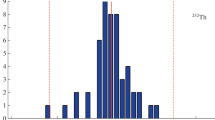Abstract
Ambient temperature variation always causes serious spectral drifts in NaI(Tl) gamma spectrum due to the temperature sensitivity of NaI(Tl) spectrometer performance. It is crucial to eliminate spectral drifts for the applications of NaI(Tl) gamma spectroscopy. In this paper, an inversion correction algorithm of gamma spectrum based on the function theory of random variables was proposed. By introducing the energy scaling factor, the theoretical deposition energy spectrum on any energy scale in detector was obtained. To validate the algorithm, the actual measured 226Ra NaI(Tl) gamma spectra with serious spectral drifts were corrected on different energy scales. The results show that the spectral drifts and spectral intensity variation were effectively eliminated on each energy scale. The maximum relative drift of peak position, the maximum relative variation of peak height and that of FWHM were 36.34, 20.92, and 19.19% before correction, respectively, and after correction, they became 0.12, 2.58, and 2.62%, respectively. These results demonstrate the feasibility and practicality of the developed algorithm in this work for applications in enhancing the confidence degree of identifying NaI(Tl) gamma fingerprints of nuclear materials and the analytical accuracy of NaI(Tl) gamma spectra.



Similar content being viewed by others
REFERENCES
Belousov, M.P., Gromyko, M.V., and Ignatyev, O.V., Instrum. Exp. Tech., 2017, vol. 60, no. 1, p. 1. https://doi.org/10.1134/S0020441217010171
Medici, S., Carbonez, P., Damet, J., Bochud, F., and Pitzschke, A., Radiat. Meas., 2020, vol. 136, p. 106426. https://doi.org/10.1016/j.radmeas.2020.106426
Bu, M., Murray, A.S., Kook, M., Helsted, L.M., Buylaert, J.-P., and Thomsen, K.J., Radiat. Meas., 2018, vol. 120, p. 253. https://doi.org/10.1016/j.radmeas.2018.07.003
Likiy, O.I., Ampilogov, N.V., Astapov, I.I., Barbashina, N.S., Kamlev, N.N., Kompaniets, K.G., Kuzmichev, L.A., Kutovoi, V.Yu., Chiavassa, A., Petru-khin, A.A., Haungs, A., Khokhlov, S.S., Shulzhenko, I.A., Shutenko, V.V., and Yashin, I.I., Instrum. Exp. Tech., 2016, vol. 59, no. 6, p. 781. https://doi.org/10.1134/S0020441216050110
Guoqiang Zeng, Chengjun Tan, Liangquan Ge, Qingxian Zhang, and Yi Gu, Appl. Radiat. Isot., 2014, vol. 85, p. 70. https://doi.org/10.1016/j.apradiso.2013.12.002
Casanovas, R., Morant, J.J., and Salvado, M., Radiat. Meas., 2012, vol. 47, p. 588. https://doi.org/10.1016/j.radmeas.2012.06.001
Wang Chongjie, Bao Dongmin, Cheng Song, and Zhang Ailian, Acta Phys. Sin., 2008, vol. 57, no. 9, p. 5361.
Wang Chong-Jie, Liu Jing-Nan, Zhou Ying-Ying, Wu Yi, and Zhao Si-Wen, Nucl. Electron. Detect. Technol., 2020, vol. 40, no. 6, p. 932.
Olmos, P., Diaz, J.C., Perez, J.M., Aguayo, P., Gomez, P., and Rodellar, V., IEEE Trans. Nucl. Sci., 1994, vol. 41, no. 3, p. 637.
Loska, L., Appl. Radiat. Isot., 1995, vol. 46, no. 9, p. 949.
Shepard, R., Wawrowski, S., Charland, M., Roberts, H., and Moslinger, M., IEEE Trans. Nucl. Sci., 1997, vol. 44, no. 3, p. 568.
Saucke, K., Pausch, G., Stein, J., Ortlepp, H.-G., and Schotanus, P., IEEE Trans. Nucl. Sci., 2005, vol. 52, no. 6, p. 3160.
Idanakiev, K.D., Alexandrov, B.S., Littlewood, P.B., and Browne, M.C., Nucl. Instrum. Methods Phys. Res., Sect. A, 2009, vol. 607, p. 432. https://doi.org/10.1016/j.nima.2009.02.019
Pratip Mitran, Arup Singha Roy, Amit K. Verma, Amar D. Pant, Prakasha, M.S., Anilkumar, S., and Vinod Kumar, A., Appl. Radiat. Isot., 2016, vol. 107, p. 133. https://doi.org/10.1016/j.apradiso.2015.10.002
Chongjie Wang, Qiuyan Zhang, Yue Sun, Jingnan Liu, Yingying Zhou, and Min Zhang, Appl. Radiat. Isot., 2021, vol. 172, p. 109671. https://doi.org/10.1016/j.apradiso.2021.109671
Luo Pengfei and Zhang Wenming, Analysis and Processing of Random Signals, Beijing: Tsinghua Univ. Press, 2006, p. 4.
ACKNOWLEDGMENTS
This work was supported by Liaoning Revitalization Talents Program (XLYC1807170) and Liaoning BaiQianWan Talents Program.
Author information
Authors and Affiliations
Corresponding author
Ethics declarations
The authors declare that they have no conflict of interest.
Rights and permissions
About this article
Cite this article
Wang, C., Miao, Y., Wang, C. et al. Inversion Correction Method for NaI(Tl) Gamma Spectra on Arbitrary Energy Scale Based on the Function Theory of Random Variables. Instrum Exp Tech 65, 362–369 (2022). https://doi.org/10.1134/S0020441222010158
Received:
Revised:
Accepted:
Published:
Issue Date:
DOI: https://doi.org/10.1134/S0020441222010158




